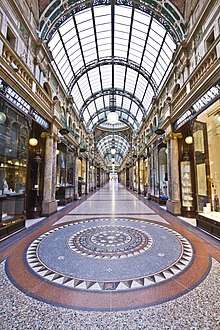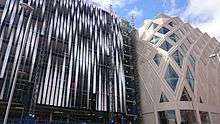Victoria Leeds
 County Arcade, Victoria Quarter | |
| Location | Leeds city centre, Leeds, England |
|---|---|
| Developer | Hammerson |
| Owner | Hammerson |
| No. of stores and services | 80 |
| No. of anchor tenants | 3 |
| Total retail floor area | 1,100,000 sq ft (102,193 m2) |
| No. of floors | 3 |
| Parking | 800 spaces |
| Website | https://www.victorialeeds.co.uk/ |
Victoria Leeds is a shopping and leisure area in Leeds city centre. It combines the 1990 Victoria Quarter (largely based on restored Victorian shopping arcades) west of Vicar Lane and the 2016 Victoria Gate shopping centre east of Vicar Lane. It includes a casino and major stores such as Harvey Nichols and John Lewis and Partners.
Victoria Quarter
The Victoria Quarter consists of three blocks between Briggate and Vicar Lane, comprising County Arcade, Cross Arcade, Queen Victoria Street and King Edward Street. It opened as The Victoria Quarter in September 1990.[1]
History
The County and Cross Arcades were built between 1898 and 1904, designed by the theatre architect Frank Matcham. They were notable for glazed barrel roofing decorated with copious amounts of faience from the Burmantofts Pottery, a number of mosaics and plentiful use of marble. Matcham's development included the Empire Theatre and all three constructions were in the same style: three storeys decorated in a free baroque style with pink and buff terracotta.[2]
In 1961, the Empire Theatre was demolished to make way for another arcade in contemporary style.[2] Having become dilapidated, the arcades were restored by Derek Latham & Co in phases between 1989 and 1996, and a coloured glass roof was erected over Queen Victoria Street.[2] The arcade that replaced the theatre was demolished and replaced by a branch of Harvey Nichols which opened in 1996, the first branch outside London.[2][1]
Victoria Gate

_009.jpg)
Victoria Gate was built on an undeveloped site adjacent to Leeds Market.The £165 million covered shopping centre opened on 20 October 2016.[3] The centre, fronting onto Eastgate, comprises a large multi-storey car park, a John Lewis store, and a U-shaped covered pedestrian area of smaller shops and businesses. The development incorporates Templar Square, a public space incorporating the listed Templar House.
History
A development known as Eastgate Quarters when announced in 2004, followed several cancelled schemes for a site that had been derelict from the 1970s to the east of Leeds city centre. The 2004 Eastgate masterplan was developed by Terry Farrell and outline planning permission was obtained in 2007. A number of architects were appointed in 2007 to design buildings in the masterplan, including the Jerde Partnership and Benoy for the Templar Arcade, Thomas Heatherwick for Harewood Quarter, ACME for the John Lewis Store and McAslan for buildings along Eastgate. The scheme was put on hold in late 2008.[4] In 2010 Hammerson announced that work had commenced on a revised masterplan and in March 2011, an outline planning application for Eastgate Quarters developed by ACME was submitted to Leeds City Council.[5] On 13 July 2011, planning permission was granted for the Hammerson scheme to proceed.[6]
References
- 1 2 "Leeds: Celebrating 20 years at Victoria Quarter". Yorkshire Evening Post. 9 September 2010. Retrieved 25 June 2018.
- 1 2 3 4 Wrathmall, Susan (2005). Pevsner Architectural Guides: Leeds. Yale University Press. pp. 24–5, 38, 159–61, 225. ISBN 0-300-10736-6.
- ↑ "Here at last: Leeds Victoria Gate shopping centre opens its doors". Yorkshire Evening Post. 20 October 2016. Retrieved 25 June 2018.
- ↑ "£800m Eastgate Quarter work postponed". Yorkshire Evening Post. Leeds, West Yorkshire: Johnston Press Digital Publishing. 9 February 2009. Retrieved 22 October 2010.
- ↑ "New Eastgate Quarter Planning application submitted". Estates Gazette.
- ↑ "Green light for £600m Eastgate scheme in Leeds". Builder & Engineer. Excel Publishing. 12 July 2011. Retrieved 29 November 2016.
External links
| Wikimedia Commons has media related to Victoria Leeds. |